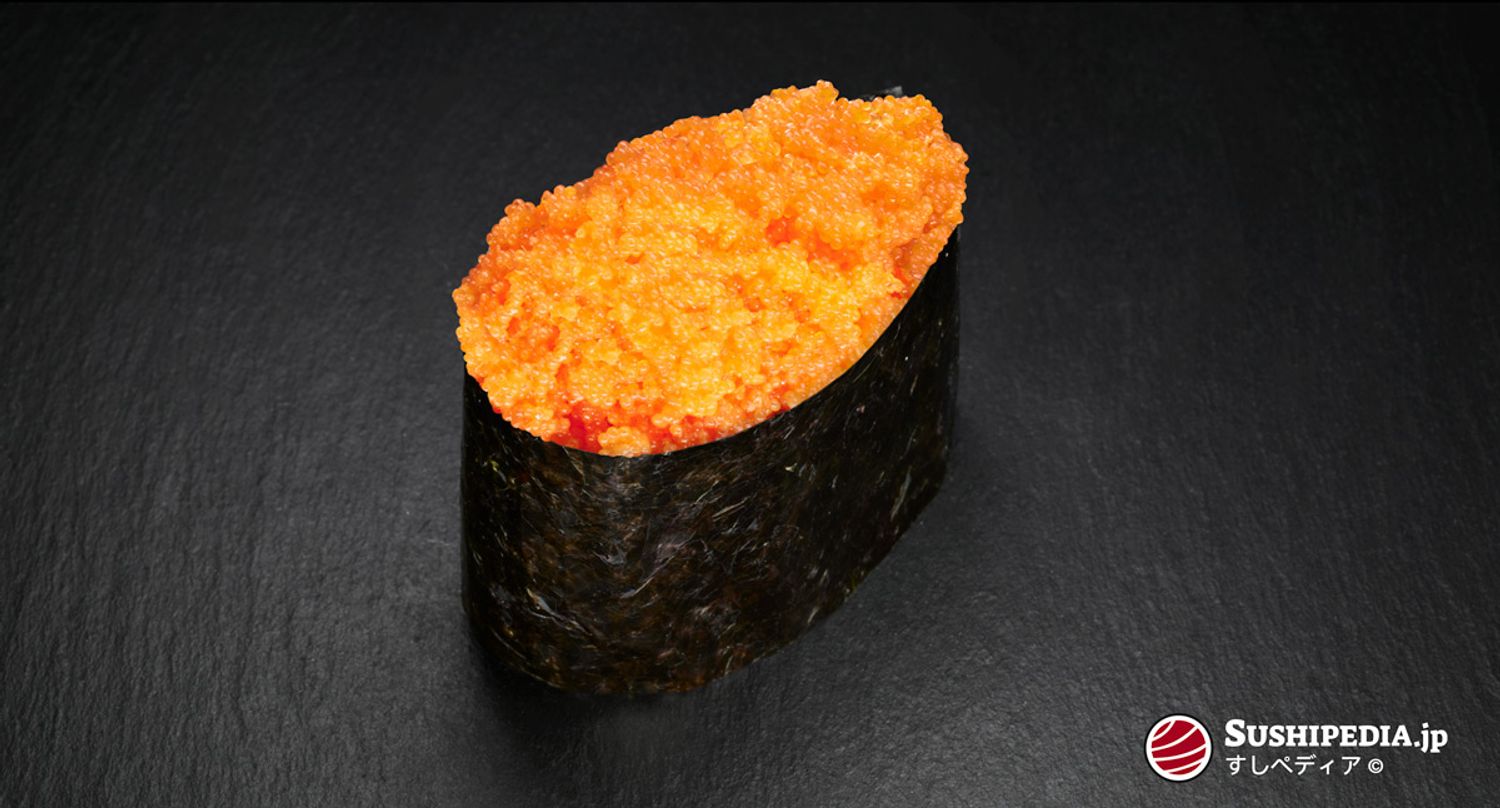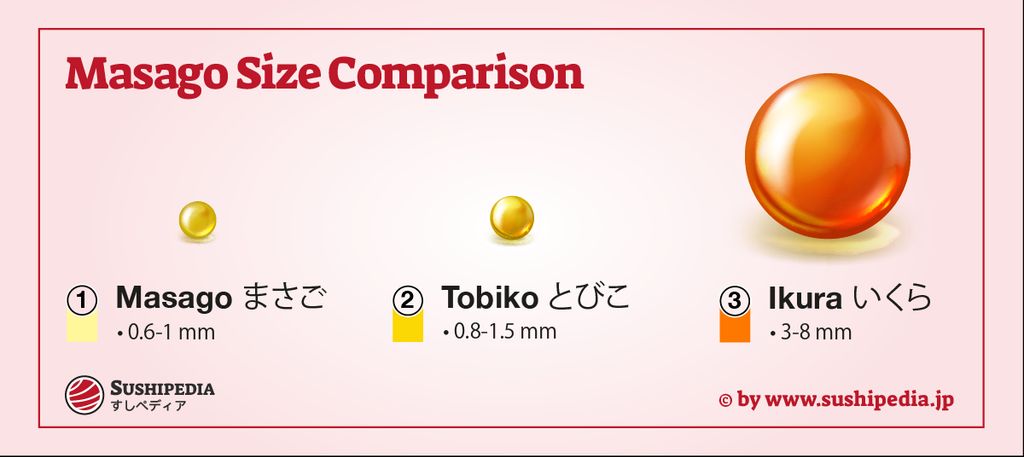Masago Sushi
A Comprehensive Overview of Shishamo/capelin Caviar or Roe in Japanese Sushi Cuisine
マサゴすし 、 真砂寿司 
What is Masago?
Masago or shishamo-ko traditionally refers to the roe of the shishamo (Spirinchus lanceolatus), a fish species of the smelt family native to Japanese waters. Given the protection of the shishamo stock and its global availability, many cuisines now use the roe of related smelt species, particularly capelin, which is called karafuto shishamo in Japanese, as an alternative. This practice allows for a more sustainable use of resources while retaining the authentic taste and texture associated with the original shishamo roe.
Masago is mainly known as an ingredient for sushi, in which it, usually brightly colored, adds a strikingly colorful note to many contemporary sushi dishes. In addition, masago is a frequently used garnish in Japan for many types of rice, noodle, and salad dishes. Whole grilled or fried shishamo, with the roe still inside the fish (ko mochi shishamo), is considered a delicacy.
Masago for Sushi or Sashimi
The taste of masago can be compared with that of tobiko. The shell of the masago egg, on the other hand, is softer and does not have the crunchy presence on the palate that is usual for tobiko. To give the eggs more taste, they are flavored after the obligatory salting. The best known and traditional variant is the marinating of masago in soy sauce.
In the upscale sushi gastronomy, masago is hardly given any attention. For the preparation of contemporary sushi rolls, which are influenced by international fusion cuisine, it is a popular ingredient and a frequent substitute for the slightly more expensive tobiko. In addition to the more classical preparation of gunkan maki, masago is often used for the preparation of sushi rolled “inside out”. In this context, variations of the california roll, which is popular in the West, are particularly noteworthy.
Most of the masago available on the market as consumer goods is industrially manufactured and has been treated with food coloring and flavoring.
Best Season
The time window to catch the capelin is relatively small and is influenced by various factors, especially with regard to the roe of the female fish. Depending on the region and spawning grounds of the populations, the fishing season extends from April to July.[1] Females whose roe is almost completely (resp. over 80 %) developed are of highest interest for the catch.[2]
The masago harvested in industrial fishing is either directly deep-frozen or further processed after extraction, so that masago from mass production is available all year round in consistent quality.
Types of Masago
Bright Masago
The natural color of the roe is very light, translucent without almost any color.[3] After treatment with salt, the taste is light and subtle. Untreated and uncolored masago is ideal for further processing with marinade.
Colored Masago
Traditionally, masago is marinated with a sauce of soy, sweet rice wine or alcohol. In contrast to the industrial varieties enriched with flavors and colorings, the traditional preparation method rewards you with a fuller and more palatable taste.
The products available on the market are almost enriched with food colorants and preservatives. Only in a few or very high-quality end products are natural ingredients added after salting the roe with sea salt.
| Designation | Taste | Industrial Colorant (US) |
|---|---|---|
| black masago | sepia (cephalopod ink) | FD&C Red #40, Blue #1, Yellow #6 |
| green masago | wasabi | FD&C Yellow #5, Blue #1 |
| orange masago | soy, mirin | FD&C Yellow #6, carmine, β-carotene |
| red masago | sweet pepper | FD&C Yellow #6, Red #40, capsicum oleoresin |
| yellow masago | yuzu, citrus | FD&C Yellow #5, turmeric oleoresin |
Masago in Japan
The word masago stands for sand in Japanese[4] although less commonly used nowadays, and is also a Japanese first name. The today more common designation and/or reading of the kanji character for sand 砂 is suna すな. Fine sand from granite rock is called masado まさど. The term sand is therefore a metaphor for the fine-grained nature of roe. The designation of masago as food with traditional characters 真砂子 for fine sand is rather odd.
The translation of the traditional characters of the shishamo fish 柳葉魚 is literally “willow leaf fish”.
Characteristics & Ecology of Masago

SushiPedia. Size Comparison of Masago, Tobiko, and Ikura. All rights reserved ©
The capelin or shishamo are small fishes which reach an approximate size between 20 and 25 cm. During the spawning period, the males develop scales covered with hair. They owe their Norse name loðinn, that means “hairy” in the Icelandic language, to this circumstance. Also, these hairs remind of the clothing of a chaplain (Christian clergy) which is why the fish is called capelan.
Economy of Masago
The development of today's industrial capelin fishery is due to Japan's increasing demand for masago in the 1980s. Capelin is caught by several nations in the waters of the northern Atlantic and Pacific. After the roe is removed from the female fish, it is first frozen and then processed or stored after landing. Roe exported to Japan is exported largely unprocessed, as Japanese companies prefer to process it themselves. The largest share of the fished masago is exported deep-frozen to Japan, China, and South Korea.[1][5]
Species for Masago
The following species are regarded as authentic masago. Either historically, according to the area of distribution or according to the common practice in today's gastronomy:
Sources and Further Reading
- [1]Capelin Northwest Atlantic Fisheries Organization Divisions 4RST (Capelin Fishing Areas 12-16). dfo-mpo.gc.ca, Fisheries and Oceans Canada, 2018-03-26. Source retrieved 12/27/2020
- [2]Capelin Roe Season Starts In Iceland. worldfishing.net, Mercator Media Ltd., Fareham, 2017-02-28. Source retrieved 12/27/2020
- [3]Alastair Fothergill. The Blue Planet, Coasts (EP08S01). BBC Natural History Unit Discovery Channel, Silver Spring. 2001. Source retrieved 1/12/2021
- [4]James Curtis Hepburn. Japanese-English and English-Japanese Dictionary, Vol. 13270-13275 in Western books on Asia: Japan. A.D.F. Randolph & Company, New York. 1873
- [5]April 2020 ISSUE, with Annual 2019 Statistics: A quarterly update on world seafood markets. GLOBEFISH Highlights (2) 45. 2020
- Sari Lehto, Maria Buchweitz, Alexandra Klimm, Raphaela Straßburger, Cato Bechtold, Franz Ulberth. Comparison of food colour regulations in the EU and the US: a review of current provisions. Food Additives & Contaminants: Part A 34 (3). 2017
- IUCN Red List of Threatened Species. Version 2023-1
Image Credits
- SushiPedia. Size Comparison of Masago, Tobiko, and Ikura. All rights reserved ©
- SushiPedia. Masago Sushi. All rights reserved ©